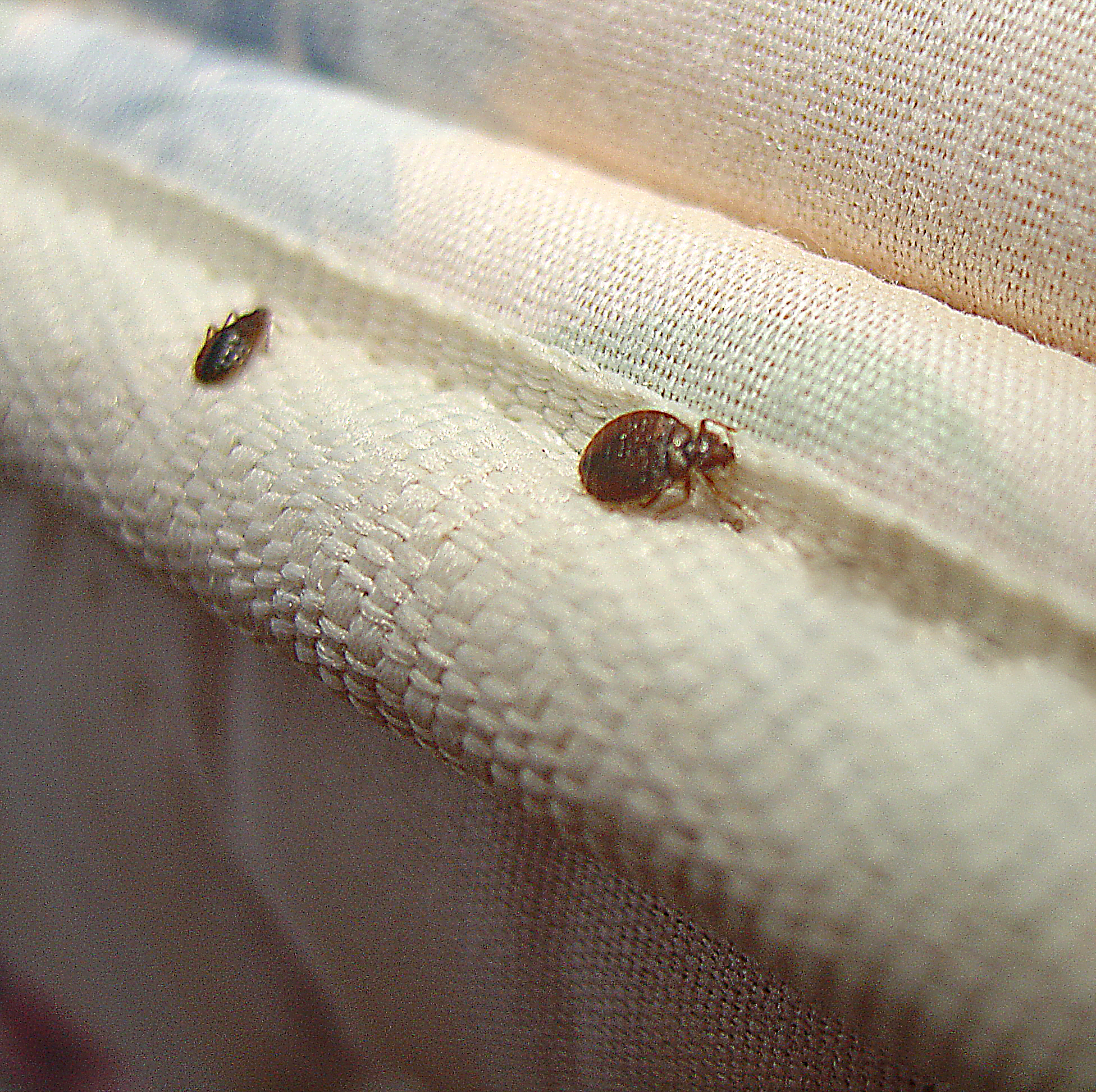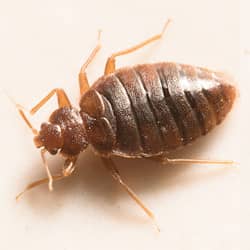How to Detect Bed Bugs
Detecting bed bugs can be difficult, as they are small in size and able to hide in tiny cracks and crevices. However, evidence of a bed bug infestation may be found in bedding and on mattresses. Live bed bugs leave clusters of dark brown or black spots of dried excrement on infested surfaces. Bed bugs also exude a subtle, sweet, musty odor.
Where to Check for Bed Bugs
Bed bugs usually are found close to where people spend much of their time, and since bed bugs have flattened bodies, they like to get into small cracks and crevice near where people sleep. Examples include mattresses, box springs, headboards, footboards, bed frames and other furniture that is within 5-8 feet of the bed. Other common locations are cracks and gaps behind wall outlets, floor molding, window and door molding and where carpet edges meet the wall. Bed bugs have been known to occur in many different locations if their population is large and they have dispersed from their more common areas to areas where they are normally less likely to be found.
Bed bugs are easily transported into previously non-infested dwellings. If you have detected a bed bug infestation within your home, contact a pest control professional to discuss treatment options.
Bed Bug Control & Removal Service
Bed bugs are troublesome household pests. They’re sneaky, hard to find, and can pose potential health risks for you and your family. Armed with pest control capabilities backed by science, over 100 years of experience, and state-of-the-art tools and products, Orkin is well-equipped to assess your bed bug problem and mount a strategic response to rid your home of the pest and provide maximum protection.
Inspection & Treatment For Active Infestations
To the untrained eye, rooting out a bed bug infestation can prove difficult, and even if discovered, home remedies and over-the-counter deterrents are often ineffective. Utilizing our A.I.M. protection process, a highly-trained Orkin specialist will assess your home, implement a solution, and monitor activity to ensure the effectiveness of our efforts and offer added peace of mind

Things That Bed Bugs Attracted
Bed bugs attracted to carbon dioxide
Generally bed bugs attracted to human beings, it’s simply because we produce carbon dioxide. This pesky little pest are also tend to settle down in areas with a high concentration of carbon dioxide.
Bed bugs attracted to warmth
Bed bugs aren’t attracted to dirt and grime, they attracted to the warmth of our bodies instead! Since human beings generate heat and warmth, bedtime is like a gold mine of warmth for bed bugs.
Bed bugs attracted to dark bed sheets
Bed bugs are accustomed to a dark environment! A recent research revealed that bed bugs attracted to certain colours, especially for red and black colours. Because these colours mimics two things that they will always go for: darkness and blood
Bed bugs attracted to dirty laundry
In the absence of a human host, bed bugs tend to seek soiled laundry as a hive. The stack of dirty laundry on your bedroom floor can be the starting point of a bed bug’s journey across the entire room. Do you know what? Bed bugs love the smell of your dirty laundry!
How do you stop bedbugs from biting you?
Bed bugs prevention is a lot easier than eliminating the existing infestation at home. These are the list of bed bugs prevention tips that you can do according to the things bed bug attracted to!

How To Get Rid of Bed Bugs
Bed bugs infestation can spread easily and it’s very difficult to treat especially when a Cimex Lectularius infestation increases in epidemic proportions, as they thrive in any weather and environment. The key to eradicating bed bugs is early detection and quick treatment by an expert pest controller.
Identify Your Pest
Bed bugs hiding in the tiniest creak and crevice makes it a challenge to spot these flat and brown crawling bloodsuckers. Sometimes, bed bugs have been mistaken as cockroach nymphs or even beetles.
In this case, you would need to be sure if your place has been infested with bed bugs to quickly take action and prevent an infestation that can get out of control in a matter of just 10 weeks!
DIY or Professional?
When it comes to getting rid of bed bugs, you have two basic options: DIY or hire a professional. The DIY option typically prove to be ineffective and risk re-infestations. This is because bed bugs shelter in the narrowest of gaps such as seams of mattresses, bedframes or behind furniture. Most of the time, many of them faced hassles and stresses dealing with an infestation.
The professional option requires you to find your local pest control company in Indonesia to get rid of bed bugs problem for you. Expert advices by trained pest specialists help you to understand control methods best suited for each individual pest biology.

TIPS FOR FINDING BED BUGS
Bug Identification
Hopefully, you will see bed bugs before they start to bite you–and before they have infested your home; but in order to see bed bugs, you have to know what they look like. These insects go through five development stages before they get to adult size. When they are first born, they are transparent and about the size of the tip on a pen. As they go through each stage, they become more reddish brown in color.
Feces
If you have bed bugs in your home, you may see their feces before you see them. These pests leave black streaks on sheets, pillowcases, and near areas they are infesting. Look for it on baseboards, outlet covers, electronics, and the backboards of beds
Insect Shells
When bed bugs develop to the next stage, they will shed their cuticle. You can find these shed skins stuck to infested areas, such as on upholstered furniture and mattress seams. You may also find these skins in your bed.
Blood Stains
When bed bugs come to feed, they often leave blood staining. This staining will often look brown on sheets and pillowcases because it will usually be found after it has had time to dry and decay. Blood staining will also be found around areas of infestation.
Bites
If you, or someone in your home, are finding mysterious bites on your skin, they may be bed bug bites. Look to see if they are in a row or cluster and whether or not there is a significant rash around them. The rash doesn’t always accompany a bed bug bite, but when it does, it makes these bites hard to miss.
HOW TO FIND AND GET RID OF BED BUGS IN YOUR HOME
Most summer bugs are a nuisance, but bed bugs are among the most persistent pests you could ever deal with. A bed bug infestation can be hard to detect at the early stages, which is when you really need to tackle it.
How Do You Get Bed Bugs?
Bed bugs can hitchhike their way into your home from just about anywhere. Most homeowners want to know how to get rid of bed bugs before this happens, especially when they’re trying to sell a property. If they get a foothold, they can spread throughout the house and even travel into neighboring homes
How to Find Bed Bugs: Why Is It Difficult?
Detecting the presence of bed bugs in your home is a little more challenging than you’d expect. A visual inspection is rarely reliable, unless it’s performed by an expert. These insects may be mistaken for other summer bugs, such as carpet bugs, and may have spread throughout your property by the time they’re correctly identified.
Feeding, Life Stages and Other Habits of Bed Bugs
If you want to know how to kill bed bugs or even find them, you have to understand how do bed bugs look like, their eating habits, preferred living conditions, reproductive cycles and behavior.
Feeding and Excretion
Bed bugs usually come out to feed at night, but will also seek a meal in daylight if they’re hungry. It can anywhere from 3 to 12 minutes for bed bugs to feed, and large nymphs or adults will often drop feces from earlier blood meals while feeding. This is what leads to the telltale dark spots on bedsheets and mattresses.Do bed bugs bite animals? Their meal of choice is generally human blood. However, they will also feed on dogs, cats and other mammals or even birds, travelling between 5 and 20 feet from their hiding spots to find a host.